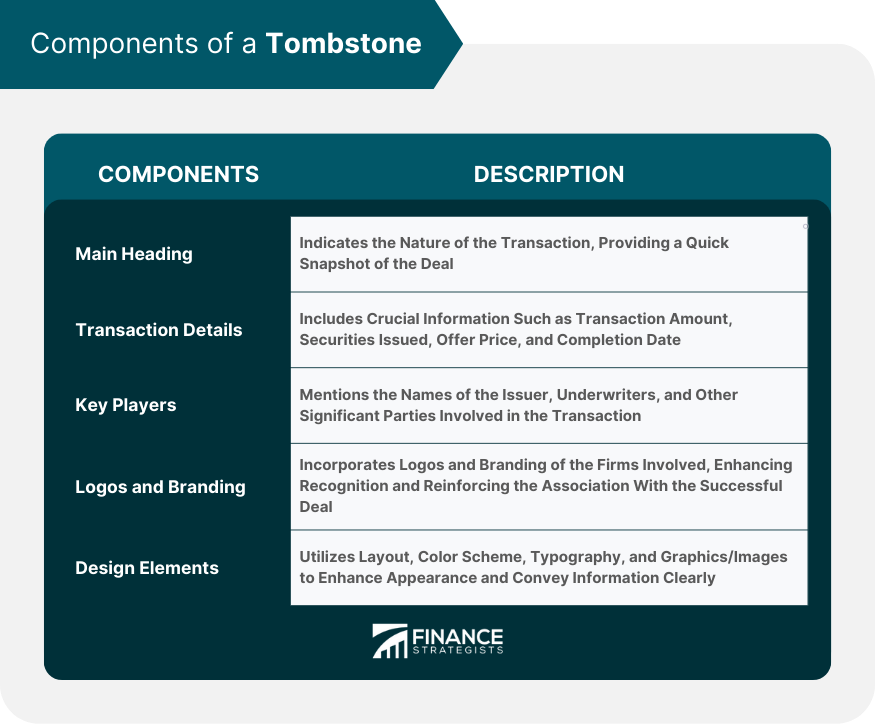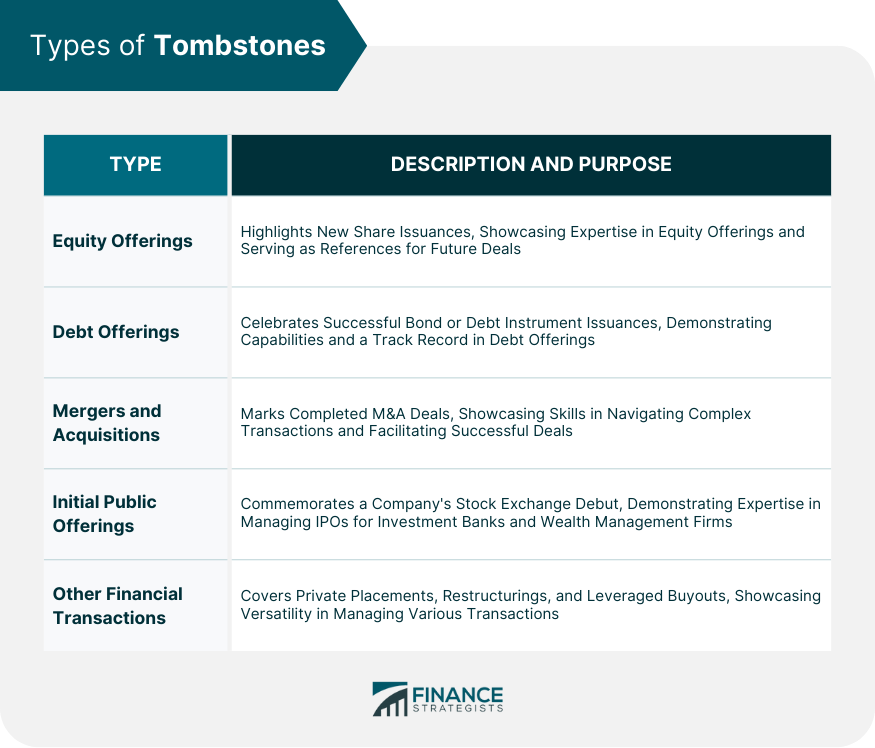A tombstone is a printed announcement and record of a completed significant transaction or deal, such as an equity or debt offering, mergers and acquisitions, or an initial public offering (IPO). It typically contains essential details about the transaction, including the names of the companies involved, the type of security being offered, the underwriters, and key financial figures. Tombstones are commonly published in newspapers, financial publications, and online platforms to inform potential investors and the public about the opportunity. These advertisements serve as a way to generate interest, create awareness, and attract potential buyers or investors to participate in the financial offering. Tombstones are designed to be concise and visually appealing, utilizing various graphics, typography, and formatting techniques to capture attention and convey the necessary information effectively. The primary purpose of a tombstone is to communicate the key details of a financial transaction. It outlines crucial information such as the nature of the transaction, the amount involved, the key players, and the date of completion. This information provides a snapshot of the transaction, offering an easy reference for future discussions or evaluations. Furthermore, it helps potential clients understand the depth of the firm's experience and its areas of expertise. Tombstones are also used to showcase the firm's achievements and expertise. By announcing and publicizing completed deals, firms highlight their skills in managing complex transactions. This demonstration of expertise helps to build the firm's reputation and credibility in the market. It can also serve as a competitive advantage, setting the firm apart from competitors who may not have a comparable track record of success. Tombstones can generate publicity for the firm and help to build client relationships. By publicizing the successful completion of transactions, firms draw attention to their capabilities and accomplishments. Moreover, by recognizing the involvement of clients and partners in the tombstone announcement, firms strengthen their relationships with these key stakeholders. This can foster loyalty and potentially lead to more business opportunities in the future. The main heading of a tombstone typically indicates the nature of the transaction. It could be "Equity Offering", "Merger & Acquisition", or "Initial Public Offering", among other transaction types. This headline serves as the primary identifier for the transaction, providing a quick snapshot of the deal for readers. The transaction details include crucial information about the deal. This may consist of the transaction amount, the number of securities issued, the offer price, and the date of completion. These details provide a comprehensive overview of the transaction, allowing readers to grasp the size and scope of the deal. The tombstone also mentions the key players involved in the transaction. This includes the names of the issuer, the underwriters, and any other significant parties involved. By acknowledging these parties, the tombstone recognizes the collective efforts that led to the successful completion of the deal. Tombstones typically include the logos and branding of the firms involved in the transaction. This enhances recognition and reinforces the association between the firms and the successful transaction. The logos and branding elements also add visual interest to the tombstone, making it more attractive and engaging. Various design elements are used in a tombstone to enhance its appearance and readability. This includes the layout, color scheme, typography, and the use of graphics or images. These elements contribute to the overall aesthetic appeal of the tombstone and help to convey the information in a clear and effective manner. Equity offering tombstones commemorate the issuance of new shares by a company. They typically highlight the number of shares issued, the offer price, the total amount raised, and the key players involved in the transaction. Such tombstones showcase the firm's expertise in managing equity offerings and provide a reference for future equity deals. Tombstones for debt offerings celebrate the successful issuance of bonds or other debt instruments by a company. These tombstones typically detail the principal amount, the interest rate, the maturity date, and the key players involved. This helps firms to demonstrate their capabilities in managing debt offerings and provides a track record of their success in this area. Mergers and acquisitions (M&A) tombstones mark the successful completion of an M&A deal. They generally provide details about the companies involved, the value of the transaction, and the date of completion. M&A tombstones highlight the firm's skills in navigating complex M&A transactions and provide a testament to its ability to facilitate successful deals. IPO tombstones commemorate a company's debut on a stock exchange. They typically outline details such as the number of shares issued, the offer price, the total amount raised, and the key players involved. These tombstones showcase the firm's expertise in managing IPOs, an essential capability for investment banks and wealth management firms. Tombstones can also be created for other types of financial transactions, including private placements, restructurings, and leveraged buyouts. Like other tombstones, these announcements provide a record of the firm's achievements and demonstrate its versatility in managing a range of different transactions. The design of a tombstone plays a significant role in its effectiveness as a marketing tool. A well-designed tombstone is visually appealing, attracting the attention of potential clients and prompting them to read the details of the transaction. Good design also enhances readability, making it easier for readers to understand the key information. The design and presentation of a tombstone should reflect the company's branding and identity. This includes the use of company colors, logos, and consistent typography. By aligning the tombstone design with the company's brand, firms can reinforce their brand identity and ensure that their tombstones are instantly recognizable. A well-designed and professionally presented tombstone conveys a professional image. It signals to clients and partners that the firm takes pride in its work and values its achievements. This can enhance the firm's reputation and increase its appeal to potential clients. Tombstones serve as valuable marketing and business development tools in wealth management. They showcase the firm's track record of successful transactions, demonstrate its capabilities, and provide tangible proof of its expertise. By publicizing these accomplishments, firms can attract new clients and generate more business opportunities. Through tombstones, wealth management firms can enhance their reputation and credibility. Successful transactions, as showcased by tombstones, attest to the firm's competence and reliability. This can boost the firm's standing in the financial community and build trust with clients and partners. Tombstones can also help to strengthen client relationships. By recognizing the involvement of clients in successful transactions, firms show appreciation for their clients' business and collaboration. This recognition can foster client loyalty, enhance client satisfaction, and pave the way for future business. A tombstone is a public announcement of a significant financial transaction or deal. It serves as a record of a firm's accomplishments and demonstrates its expertise in managing complex transactions. Tombstones play a crucial role in wealth management, helping firms to attract new clients, build their reputation, and strengthen client relationships. A tombstone typically includes a main heading, details of the transaction, names of key players, logos and branding, and design elements. These components provide a comprehensive overview of the transaction and contribute to the tombstone's visual appeal and readability.What Is a Tombstone?
Purpose of Tombstones
Communicating Key Details of Financial Transactions
Showcasing Achievements and Expertise
Generating Publicity and Building Client Relationships
Components of a Tombstone
Main Heading
Transaction Details
Key Players
Logos and Branding
Design Elements

Types of Tombstones
Equity Offerings
Debt Offerings
Mergers and Acquisitions
Initial Public Offerings (IPOs)
Other Financial Transactions

Importance of Tombstone Design and Presentation
Attractiveness and Visual Appeal
Reflecting the Company's Branding and Identity
Conveying a Professional Image
Role of Tombstones in Wealth Management
Marketing and Business Development
Enhancing Reputation and Credibility
Strengthening Client Relationships
Conclusion
Types of tombstones encompass equity offerings, debt offerings, mergers and acquisitions, initial public offerings, and other financial transactions, each serving as a distinctive representation of the specific transaction.
Tombstone FAQs
A tombstone is a printed announcement of a significant financial transaction or deal. It serves as a record of the deal and as a marketing tool for the firms involved.
A tombstone typically includes a main heading, transaction details, the names of key players, logos and branding, and design elements.
Tombstones are important in wealth management because they showcase a firm's track record, enhance its reputation and credibility, and help to build and strengthen client relationships.
Tombstones can be used to announce a wide range of transactions, including equity offerings, debt offerings, mergers and acquisitions, initial public offerings, and other significant financial deals.
A tombstone is designed to be visually appealing and to convey key information about a transaction in a clear and effective manner. It should reflect the company's branding and identity and convey a professional image.
True Tamplin is a published author, public speaker, CEO of UpDigital, and founder of Finance Strategists.
True is a Certified Educator in Personal Finance (CEPF®), author of The Handy Financial Ratios Guide, a member of the Society for Advancing Business Editing and Writing, contributes to his financial education site, Finance Strategists, and has spoken to various financial communities such as the CFA Institute, as well as university students like his Alma mater, Biola University, where he received a bachelor of science in business and data analytics.
To learn more about True, visit his personal website or view his author profiles on Amazon, Nasdaq and Forbes.











